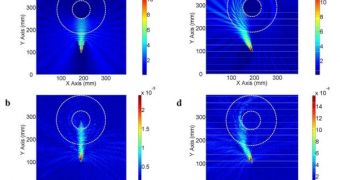Far from being the only ones attempting to create an artificial black hole, Chinese researchers recently announced that they were able to produce the first artificial black hole for microwaves. If light in this energy spectrum enters the construct, it can no longer leave it, the team reports. Its accomplishment was made possible through the use of metamaterials, the same components that form the basis for invisibility cloaks and other optoelectronic devices, Technology Review reports.
In charge of the Chinese team were scientists Qiang Cheng and Tie Jun Cui, both from the State Key Laboratory of Millimeter Waves, at the Southeast University in Nanjing. Renowned physicist Albert Einstein explained in his work that black holes appeared when a region of space was so distorted by the enormous mass it contained, that light could no longer escape its gravitational pull, and got sucked in. This is one of the main reasons why black holes everywhere in the Universe are black, astronomers say.
In the new research, gravity played but a minor role. The main stars were metamaterials, which can also distort space, but only from the point of view of light. That is to say, the materials themselves do not cause the area where they reside to exhibit a stronger gravitational pull, but they mix up the path that light usually travels on. This essentially means that the photons making up the light cannot escape the “maze” before them, and remain trapped inside the material forever. This makes it a black hole.
A similar property is being exploited when metamaterials are used for invisibility cloaks. The only difference is that, in the latter instance, they are used not to capture light, but to bend it and then allow for it to flow past an object, without reflecting back off it. The new black hole is made up of 60 layers of printed circuit boards, each of them coated with a layer of copper. On the copper, the researchers etched patterns that either resonated with light (microwaves) or did not.
Microwaves fired at the structure at a frequency of 18 GHz proved unable to get past it. They were absorbed from all directions at the same time, and the energy they imprinted on the disks was released as heat. This essentially means that the first artificial black hole for microwaves is now a reality.

 14 DAY TRIAL //
14 DAY TRIAL //